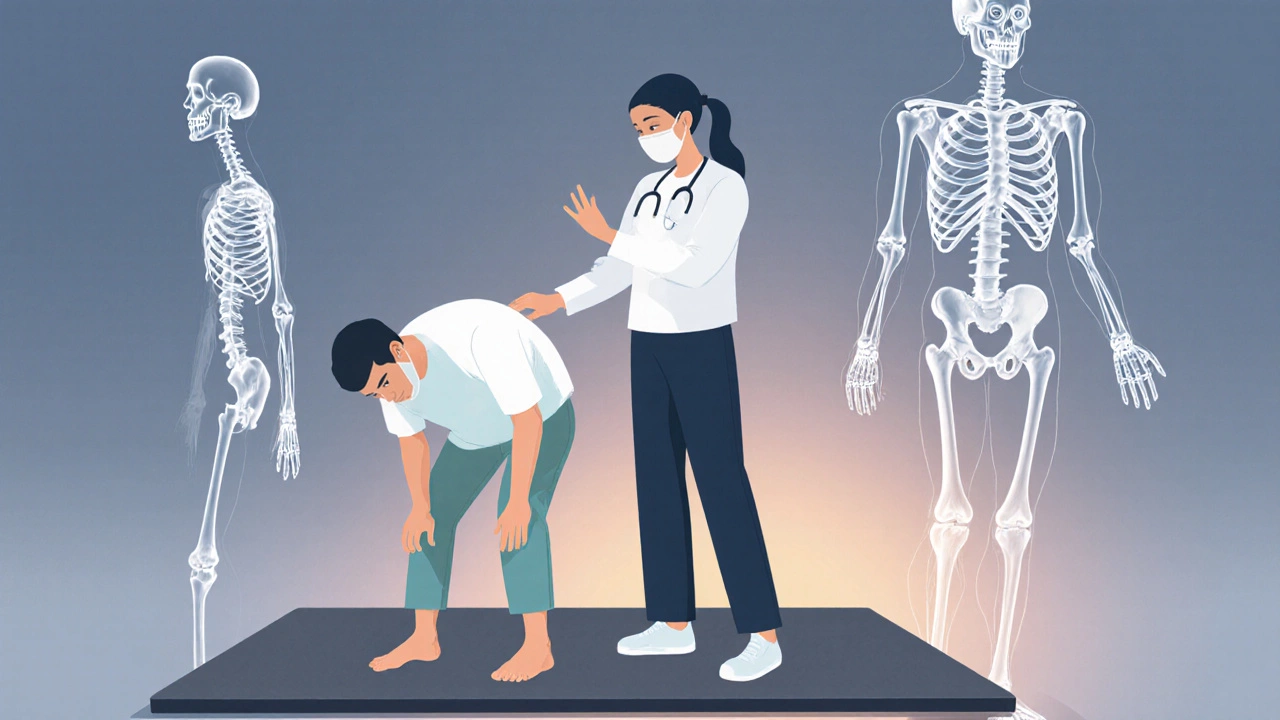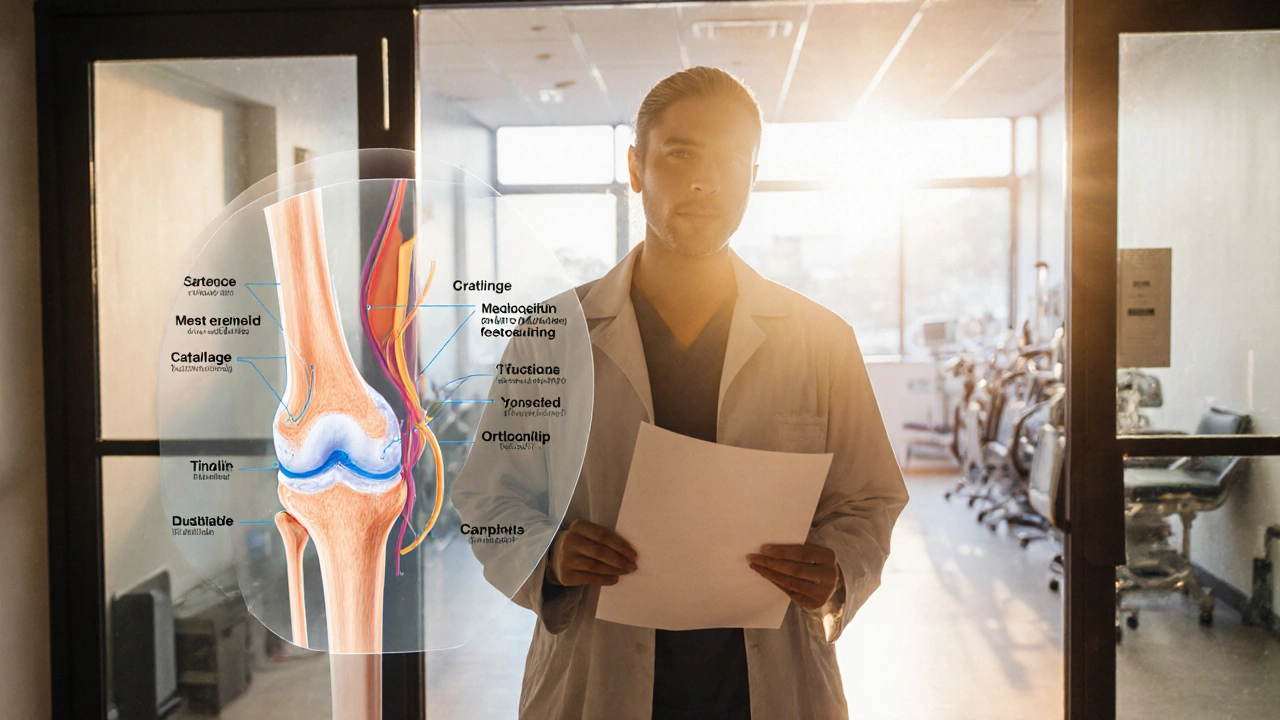
Orthopedic Imaging Assessment Tool
Symptom Assessment
This tool helps you understand if your symptoms meet guidelines for imaging during your first orthopedic visit.
Walking into an orthopedic surgeon’s office for the first time can feel overwhelming. You’ve probably been dealing with pain, stiffness, or limited movement for weeks-or maybe even years. You’ve tried rest, ice, painkillers, physical therapy. Nothing stuck. Now you’re here, wondering: what will the orthopedic surgeon do on the first visit? The good news? It’s not as scary as it seems. Most first visits follow a clear, practical path designed to find the root of your problem-not just mask it.
They’ll Start by Listening-Really Listening
Before you even take off your shirt, the surgeon will ask you questions. Not just any questions. The kind that make you pause. When did the pain start? What makes it worse? Did you fall, twist, or just wake up one day with it? They want the story. Not just the symptom. A knee that started hurting after a soccer game is different from one that ached slowly over six months. A back pain that shoots down the leg tells a different story than one that’s stiff in the morning. They’re looking for patterns. Red flags. Clues.They’ll also ask about your daily life. Do you sit at a desk all day? Do you walk your dog every morning? Are you still playing golf or gardening? These aren’t small talk. They help the surgeon understand how your body moves-and where it’s breaking down. A dancer’s hip issue looks different from a construction worker’s. Your lifestyle shapes your diagnosis.
The Physical Exam Is More Than Just Pressing on Your Knee
After the conversation, you’ll be asked to move. This isn’t a quick poke-and-prod. It’s a full movement assessment. The surgeon will watch how you walk, stand, sit, bend, squat. They might ask you to hop on one foot, walk on your heels, or do a deep knee bend. They’re not checking for pain alone-they’re checking for how you move with pain.They’ll test your range of motion. Can you fully straighten your elbow? Can you rotate your shoulder without pain? They’ll check muscle strength by asking you to push or pull against their hand. They’ll test nerve function with light taps and reflex checks. If your knee is the issue, they might perform special maneuvers like the McMurray test for meniscus tears or the Lachman test for ACL damage. These aren’t random. Each test targets specific structures.
Don’t be surprised if they compare both sides. If your right hip hurts, they’ll check your left hip too. Sometimes the problem isn’t just in the painful area-it’s in how your whole body compensates.
They Might Order Imaging-But Not Always
You might expect an X-ray or MRI right away. But here’s the truth: most orthopedic surgeons won’t order imaging on the first visit unless there’s a clear red flag. Why? Because many common issues-like tendonitis, mild arthritis, or muscle strains-show up just fine on physical exam. Imaging is expensive. It can show “abnormalities” that aren’t actually causing your pain.They’ll only order scans if:
- You have sudden, severe trauma (like a fall or car accident)
- You have numbness, tingling, or weakness in your limbs
- Pain is getting worse despite rest
- There’s swelling, redness, or fever (signs of infection)
- They suspect a fracture, tumor, or serious ligament tear
When they do order imaging, it’s usually X-rays first. They’re fast, cheap, and great for seeing bones. If they need to see soft tissues-ligaments, tendons, cartilage-they’ll schedule an MRI. Ultrasounds are also common for shoulder or tendon issues. You won’t get an MRI just because you asked for it. The surgeon picks the right tool for the job.

They’ll Give You a Working Diagnosis-Not a Final One
By the end of the visit, you’ll hear a diagnosis. But it’s not set in stone. It’s a working diagnosis. Something like: “Your symptoms suggest early osteoarthritis in your right knee, likely worsened by repetitive stair climbing.” Or: “You have rotator cuff tendinopathy, probably from overhead lifting.”This diagnosis guides the next steps. It’s not a label to live with-it’s a starting point. The surgeon will explain what’s happening in simple terms. No jargon. They’ll show you diagrams if needed. They’ll tell you what’s normal wear and tear and what’s something that needs attention.
They’ll also tell you what’s not wrong. That’s just as important. Many people worry they have cancer or a rare disease. The surgeon will rule those out quickly. Most joint pain isn’t life-threatening. It’s mechanical. And that’s good news-it means it’s often fixable.
You’ll Leave With a Clear Plan-Not Just a Prescription
The goal of the first visit isn’t to hand you a script for painkillers. It’s to give you a plan. That plan usually has three parts:- Immediate relief: Maybe a short course of anti-inflammatories, a brace, or advice on avoiding certain movements.
- Rehabilitation: Most cases respond to physical therapy. They’ll refer you to a physiotherapist who knows your specific issue. You might get a set of home exercises-stretching, strengthening, mobility drills.
- Follow-up: When to come back. What signs mean you need to return sooner. What improvement looks like over 4-6 weeks.
Some people walk out thinking surgery is the only answer. But surgery is the last resort for most orthopedic problems. Only 10-15% of first-time orthopedic patients end up needing surgery. The rest improve with conservative care. Your surgeon will tell you if you’re one of them.

What to Bring to Your First Visit
To make the most of your appointment, come prepared:- A list of all medications and supplements you take-including dosages
- Any prior imaging (X-rays, MRIs) on a USB drive or digital copy
- Notes on when symptoms started, what triggers them, and what helps
- Questions written down-you’ll forget them in the moment
- Comfortable clothing that lets you move freely (shorts for knee issues, tank top for shoulder)
Don’t rely on memory. Bring your phone’s notes, a paper list, even a voice recording. This visit is your chance to get clarity. Don’t waste it.
What Happens If Nothing Changes After a Few Weeks?
If you follow the plan-take the meds, do the exercises, avoid the aggravating movements-and you’re not better in 4-6 weeks, you’ll go back. That’s normal. Progress isn’t always linear. The surgeon might then order imaging, adjust your rehab plan, or consider an injection like a cortisone shot to reduce inflammation and help you start therapy.Surgery is still not automatic. Even if you need a knee replacement, the surgeon will want you to try everything else first. They’ll want to see you’ve committed to rehab. That’s not just protocol-it’s science. Patients who do their rehab before surgery heal faster and have better outcomes.
Most People Feel Better After the First Visit-Even Before Treatment Starts
Here’s something surprising: many patients leave feeling lighter-even if they didn’t get a cure yet. Why? Because they finally have an answer. No more guessing. No more “it’s just aging.” They know what’s wrong, what’s not, and what to do next. That reduces anxiety. And anxiety makes pain worse.That’s the real win of the first visit. You’re no longer lost. You have a map. And maps make even long journeys feel possible.
Do I need to bring my previous medical records?
Yes, if you have them. Bring any past X-rays, MRIs, or doctor’s notes-even from years ago. They help the surgeon see how your condition has changed over time. If you don’t have them, don’t panic. Most clinics can request records from your previous providers with your permission.
Will the orthopedic surgeon prescribe painkillers?
Maybe-but not as the main solution. They might give you a short-term prescription for NSAIDs like ibuprofen to reduce inflammation and help you move better while you start physical therapy. But long-term painkillers aren’t the goal. The focus is on fixing the cause, not just hiding the pain.
Can I just get an MRI on my first visit?
Not usually. MRIs are expensive and not always necessary. Most orthopedic problems can be diagnosed with a good exam and history. Imaging is only ordered if there’s a red flag or if conservative treatment fails. Getting an MRI too early can lead to unnecessary worry over findings that aren’t causing your pain.
How long does a first orthopedic visit usually take?
Most first visits last between 45 and 75 minutes. The longer time is because the surgeon needs to listen, examine, explain, and plan with you. Don’t rush it. This is your time to get answers.
What if I’m not sure which specialist I need?
That’s okay. Orthopedic surgeons are trained to handle a wide range of musculoskeletal issues-from ankles to spines. If your problem seems to overlap with neurology, rheumatology, or sports medicine, they’ll refer you to the right person. You don’t need to know the exact specialty-just describe your symptoms clearly.





